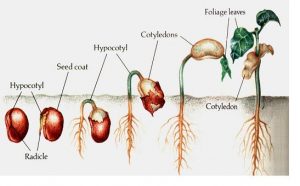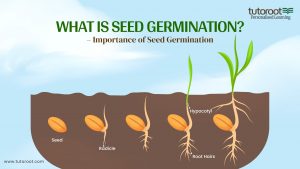What is Seed Germination? Importance of Seed Germination
Introduction
Seed germination is a crucial biological process that starts the life cycle of plants. It is the development of a seed into a new plant, starting from a dormant seed to a growing seedling. Understanding seed germination is crucial for students, gardeners, farmers, and anyone interested in plant biology. This article delves into the definition, importance, process, and conditions necessary for seed germination, providing a comprehensive guide to this fascinating phenomenon.
What is Seed Germination?
Seed germination is the process where a seed grows into a new plant. It involves the activation of the seed’s metabolic machinery, leading to the growth of the embryonic plant contained within the seed. This process begins when the seed is exposed to the right conditions, including water, oxygen, and suitable temperature. During germination, the seed takes in water, swells, and eventually splits its coat, allowing the embryonic root (radicle) to emerge and grow into the soil.
Importance of Seed Germination
Seed germination is vital for several reasons:
- Plant Propagation: Germination is the primary method through which plants reproduce and propagate. It ensures the continuation of plant species and maintains biodiversity in ecosystems.
- Food Production: Most of the world’s food supply relies on seed germination. Crops such as wheat, rice, corn, and legumes germinate from seeds, providing essential food sources for human and animal consumption.
- Ecological Balance: Germinating seeds play a crucial role in maintaining ecological balance. They help in soil stabilization, prevent erosion, and support wildlife by providing habitat and food sources.
- Agricultural Practices: Understanding germination is key to successful farming. Knowledge of germination helps farmers optimize planting strategies, improve crop yields, and develop better agricultural practices.
- Conservation Efforts: Seed banks and conservation programs rely on germination to preserve endangered plant species. By storing seeds and promoting their germination, these programs ensure the survival of rare and threatened plants.
Schematic Diagram of Seed Germination
This visual representation helps in understanding the sequential steps and the transformation of the seed. In the diagram, you would see the seed absorbing water, swelling, and the emergence of the radicle, followed by the shoot pushing upward and the development of the first leaves.
A schematic diagram of seed germination shows the stages from seed to seedling. Typically, the diagram includes the following steps:
- Imbibition: The seed takes up water, causing it to swell and activate its metabolic processes.
- Radicle Emergence: The root (radicle) breaks through the seed coat and anchors the seedling.
- Plumule Emergence: The shoot (plumule) emerges, growing upward to reach light.
- Seedling Growth: The seedling develops leaves and begins photosynthesis, establishing itself as an independent plant.

Process of Seed Germination
The process of seed germination involves several stages, each crucial for the successful development of a seedling:
- Imbibition: This initial stage involves the absorption of water by the seed. Water uptake triggers the seed’s metabolic processes, activating enzymes that break down stored food reserves.
- Activation of Metabolism: Enzymes break down starches, proteins, and fats stored in the seed into simpler molecules. These molecules provide the energy and building blocks needed for the growing embryo.
- Radicle Emergence: The radicle, or primary root, is the first part of the seedling to emerge. It penetrates the soil, anchoring the seedling and absorbing water and nutrients.
- Plumule Emergence: The plumule, or shoot, emerges next. It grows upward, pushing through the soil to reach light. This is essential for the plant to begin photosynthesis.
- Seedling Establishment: The seedling develops its first true leaves and begins photosynthesis. It now relies on sunlight for energy and continues to grow and develop into a mature plant.
Seed Germination Steps
Let’s explore each step of seed germination in detail:
1. Imbibition:
- The seed takes in water, causing it to swell.
- Water triggers enzymes that break down stored food reserves.
- The seed coat softens, enabling the radicle to emerge.
2. Radicle Emergence:
- The radicle breaks through the seed coat.
- It anchors the seedlings in the soil.
- The radicle absorbs water and nutrients essential for growth.
3. Plumule Emergence:
- The plumule pushes through the soil.
- It grows upward to reach light.
- This step is crucial for initiating photosynthesis.
4. Seedling Growth:
- The seedling develops its first true leaves.
- Photosynthesis begins, providing energy for growth.
- The seedling continues to grow, eventually becoming a mature plant.
Important Factors Affecting Seed Germination
Several factors influence seed germination, including:
- Water: Essential for activating enzymes and softening the seed coat.
- Oxygen: Necessary for cellular respiration and energy production.
- Temperature: Optimal temperature ranges vary by species but generally fall between 20-30°C.
- Light: Some seeds need light for germination, while others require darkness.
- Seed Dormancy: Some seeds have dormancy mechanisms that must be broken before germination can occur.
Conditions to Know in Germination
Understanding the conditions that affect germination is crucial for successful plant growth:
- Moisture: Seeds need adequate moisture for imbibition but should not be waterlogged.
- Aeration: Proper soil aeration ensures oxygen availability for the germinating seed.
- Temperature: Maintaining optimal temperatures is essential for enzyme activity and growth.
- Light Exposure: Depending on the species, seeds may require light or darkness to germinate.
- Soil Quality: Nutrient-rich, well-draining soil supports healthy seedling development.
Final Notes
Seed germination is a complex yet fascinating process that marks the beginning of a plant’s life cycle. Understanding the stages and factors involved in germination can help students, gardeners, and farmers optimize plant growth and ensure successful cultivation. By providing the right conditions, anyone can witness the miracle of seed germination and contribute to a greener, more sustainable world.
Looking for clear and concise explanations of various concepts? Check out the Tutoroot Blog for simplified learning experiences. Enhance your understanding of subjects and get your questions answered with Tutoroot’s Biology Online tuition. Start your learning journey with Tutoroot’s online tuitions by scheduling a FREE DEMO session today.
FAQs
What are Seed Germination Stages?
The stages of seed germination include imbibition, activation of metabolism, radicle emergence, plumule emergence, and seedling establishment.
Name the 5 Stages of Seed Germination.
The five stages of seed germination are:
- Imbibition
- Activation of Metabolism
- Radicle Emergence
- Plumule Emergence
- Seedling Growth

